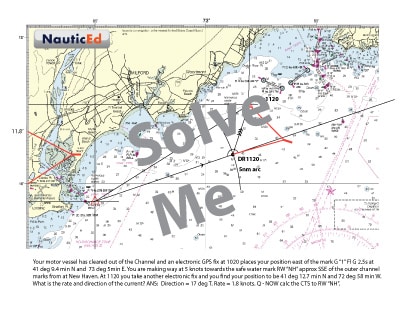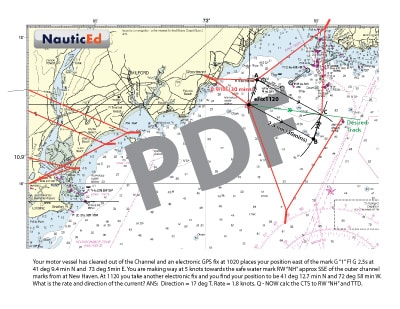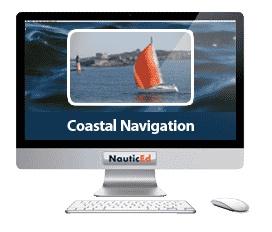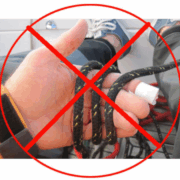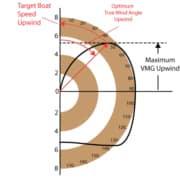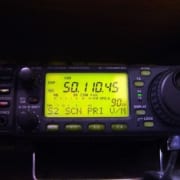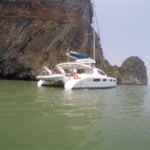How to Calculate Course To Steer (CTS)
If you like our problems and solutions, LIKE us on facebook and g+1 us. It really helps us grow – thanks for that. AND you’ll get instant notification when we make a new problem or post a solution. How cool is that?
Course to Steer Calculation
Given the last Rate and Direction problem, now calculate the CTS (Course to Steer) to go to the safe water mark RW “NH” and the TTD (Time to Destionation)?
Answer is posted below. BUT please give it a go first to test your current knowledge.and post your answer to our
Here is the Answer plot (no cheating – give it a go first) (no really) (oh come on really – give it a go first)
In this answer plot we used 1/2 hour for the time frame. Thus with current flowing at 1.8 knots in 1/2 hour the distance the current will push you off course is 0.9 nm at 17 deg T. Your speed is 5 knots through the water so in 1/2 hour you would travel 2.5 nm.
In the answer plot I have done it two ways. Both work equally as well. First I drew the desired track from the eFix through the buoy RW “NH”. The first vector I plotted was from the eFix to Point A using the current vector (0.9 nm at 17 deg T). Then from Point A, I scribed a 2.5 nm arc to cross the desired track. This gives me position C. I drew a line from Point A to Point C. This gives me what is called a water track. Designated by 1 arrow (mnemonic “water has one”). I measured this direction which is 118 deg T. This is the CTS (Course to Steer). It means if your boat heading is 118 T then your ground track will be from the eFix position towards point C AND towards the Buoy RW “NH” since it lies on the same line.
The distance from the eFix Position to Point C is 2.5 nm. Since you will travel at 5 knots this will take you 30 minutes. NOTE: it is just by pure coincidence that this is the same speed as the boat through the water in this case. i.e. the way you find the boat speed over ground is to measure the distance from the eFix to point C and divide by the time. In this case it just so happened that the distance from eFix to Point C is the same distance as Point A to Point C. You can imagine it would be totally different if the current direction was 30 deg T instead of 17 deg T.
NOTE: also I have solved the problem using the vectors in a different manner. First I scribed an arc 2.5 nm out from the eFix Position. Then I brought in the current vector so that the end was touching the desired track line and moved it until the start touched the scribed arc. This result satisfies the condition that the boat must move 2.5 nm whilst the current brings the boat back to the desired track. The start of the current vector creates Point B. Then I drew a line from eFix to B to create the water track. The water track is the heading of the boat. The heading is (and must be) exactly the same as before at 118 deg T.
This second method, just to me, seems to make more sense of a vector triangle because I can see the boat starting from the eFix and heading out at 118 and getting dragged back to the desired track line. Maybe it’s just me. In any case the triangles are exactly the same. I believe however, that using the first triangle method may be more accurate in real live plotting because you draw the lines from exact points. In the second method, you’re moving that current line to satisfy the two conditions. My brain however, thinks the first method looks weird. i.e. the current drags you all the way out and you have to crawl back. In either case this is not reality. In reality, your boat just follows the desired track. If your mind can handle the first method do it that way.
Next part of the problem is to calculate TTD – the time it takes to get to the buoy.
That’s easy – the distance is 3.2 nm. At 5 knots this will take 0.64 hours = 38.4 minutes.
Now could you solve this problem if the was ALSO 10 degrees of leeway with the wind out of the North?
If you need help, consider taking our Coastal Navigation online class or our iPad eBook App Coastal Navigation course these types of problems and solutions are taught throughout the course.
Permission for a rant? (if you know me, I break out in rants every now and then. It’s a collection of thoughts and I tell you its a rant so as not to offend – ie don’t read this if you’re sensitive)
START RANT
This problem should be second nature to you. In reality, you’re probably not solving these problems everyday whilst sailing and it’s why some people think they can get away without knowing this stuff. However, this is fundamental to sailing and I think it is irresponsible (strong word – I said it was a rant) to not be able to lay out the method to solve this problem. Laying out the method means you grasp the concept which is the most important to understanding and keeping you out of trouble.
Example: Last year whilst sailing from St. Lucia south to St. Vincent we saw a sailboat way to the west almost on the horizon about half way across. He had left St Lucia and held a compass heading towards St. Vincent. In the meantime, we calculated a CTS and sailed in a straight line over ground to St. Vincent. His path was a complete arc which took him miles off course. Our path was the shortest distance between two points ( a straight line). I’d call this guy a crappy sailor – I know this because of another rant that I wrote about the same guy when it comes to a crossing and give way situation later on as we approached our bay on St. Vincent [see that blog article and story].
Don’t be a crappy sailor – sail with knowledge. It might seem like a selfish rant to get you to buy more courses – maybe or maybe it is and an attempt to reduce the number of crappy sailors out there. NauticEd courses are ridiculously amazing value and after taking at least our Bareboat Charter Master Bundle of courses, I guarantee you will not be on Neptune’s naughty list.
Personally, I’m impressed with the European community and requiring the ICC for all sailors. The ICC requires the above type knowledge. When you’re sailing in Croatia, Greece, France etc, on a Bareboat Charter, you’re nervous enough. You don’t want all the other charter skippers having limited sailing knowledge. If you know they all have the ICC, you’re going to be a lot more comfortable in a crossing situation.
NauticEd has taken it a step further by not only providing the ICC but offering the Bareboat Charter Master bundle of courses. These courses really ready you for a proper safe Bareboat Chartering Experience.
END RANT
Do you have your Mediterranean Sailing License (the ICC or the SLC) yet?
Click here to find out about the required Sailing License for the Mediterranean if you’re wanting to sail in Europe. The ICC and the SLC are accepted by Yacht Charter Companies worldwide – no questions. Get yours now simply through NauticEd.

